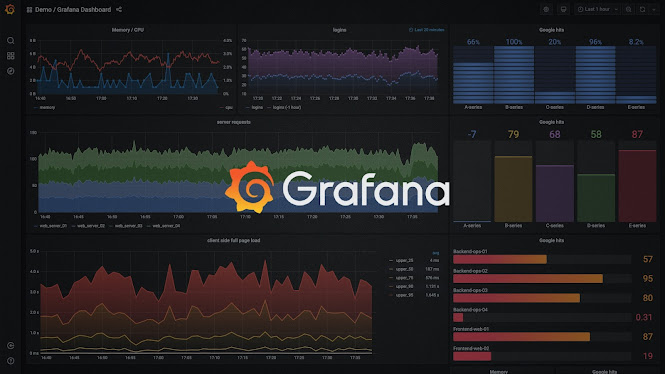Setup Grafana on AWS EKS and integrate with AWS Cloudwatch

What is Grafana?
Grafana is open-source visualization and analytics software. It allows you to query, visualize, alert on, and explore your metrics no matter where they are stored. In plain English, it provides you with tools to turn your time-series database (TSDB) data into beautiful graphs and visualizations.Setup Grafana on Amazon Elastic Kubernetes Service

This blog explains on how to run Grafana on Amazon Elastic Kubernetes cluster and adding cloudwatch as datasource to Grafana. Using Grafana you can simplify Kubernetes monitoring dashboards from CloudWatch metrics. Let’s look
into the detailed deployment steps.
Deploying EKS cluster and nodes
We are deploying EKS and required networking resources using CloudFormation template. CloudFormation will create below resources:
- IAM Role for EKS
- VPC
- Two Public Subnets and Two Private Subnets
- Internet Gateway
- Two NAT Gateways
- Public Route Table and its appropriate association
- Two Private Route Tables
- Control Plane Security Group
- EKS
Lets deploy the CloudFormation by cloning the repo
eks-kubernetes-grafana-cloudwatch
Login to AWS account and the region where you want to deploy this setup and go to CloudFormation Service
Create Stack by uploading the CloudFormation template "eks_cluster_template.yaml

In Next Page, pass the parameters as per your requirement


Click Next and Go to Final Page of CloudFormation and acknowledge the IAM role creation and Create the stack.


Wait for stack to reach create complete state



EKS Cluster is created with all the required configuration. Now we will create the node group for the cluster. Before creating the node group, we need IAM role for the node group.
Go to IAM console and click on create role

Attach below managed policies which are required for EKS nodes

- AmazonEKSWorkerNodePolicy
- AmazonEC2ContainerRegistryReadOnly
- AmazonEKS_CNI_Policy


Once IAM role creation for node is completed, Go to AWS EKS and click on EKS configuration and go to compute and add Node Group

Enter the Node group name and select the role which we created in previous steps

Pass the values as per your requirement on instance Type, size and scaling configuration



After node group is created, you will be seeing the nodes in Ready state


Validate the nodes from your local machine using kubectl

Now all set with Infrastructure and EKS environment, now time to deploy Kubernetes manifests - deployment, data-source and ingress service.
Deploying Grafana and CloudWatch data source on EKS
We will start with creating an IAM role for Grafana to read the CloudWatch metrics. I have created a role and attached below managed polices.

- AmazonEC2ReadOnlyAccess
- CloudWatchReadOnlyAccess

You can even granularize the permission by looking into the
Grafana official website
Trust the Grafana role with EKS node role

In this demo, Grafana will fetch the CloudWatch metric from the same account. If you want to monitor different AWS Account(s) then in the target account, create IAM role for Grafana and trust the role with EKS node role where Grafana is containerized.
- Grafana data-source config file : CloudWatch data source is integrated with ConfigMap
- deployment file : Grafana configuration and deployment file
- service file : Ingress to access the Grafana URL with load balancer URL
Step 1: Create the namespace
For this demo, I have used monitoring as a namespace
kubectl create namespace monitoring

Step 2: Create the ConfigMap
Below is the data-source yaml file for Grafana with CloudWatch data-source. Change the "assumeRoleArn" to the your Grafana role.
apiVersion: v1kind: ConfigMapmetadata:name: grafana-datasourcesnamespace: monitoringdata:cloudwatch.yaml: |-{"apiVersion": 1,"datasources": [{"name": "cw-data-dev","editable": true,"type": "cloudwatch","jsonData":{"authType": "arn","defaultRegion": "ap-south-1","customMetricsNamespaces": "","assumeRoleArn": "arn:aws:iam::<AWS_Account_ID>>:role/grafana_role",}}]}
Run the below command to create the config map for Grafana data-source
kubectl create -f grafana-datasource-config.yaml -n monitoring
Step 3: Create the deployment
apiVersion: apps/v1kind: Deploymentmetadata:name: grafananamespace: monitoringspec:replicas: 1selector:matchLabels:app: grafanatemplate:metadata:name: grafanalabels:app: grafanaspec:containers:- name: grafanaimage: grafana/grafana:latestports:- name: grafanacontainerPort: 3000resources:limits:memory: "1Gi"cpu: "1000m"requests:memory: 500Mcpu: "500m"volumeMounts:- mountPath: /var/lib/grafananame: grafana-storage- mountPath: /etc/grafana/provisioning/datasourcesname: grafana-datasourcesreadOnly: falsevolumes:- name: grafana-storageemptyDir: {}- name: grafana-datasourcesconfigMap:defaultMode: 420name: grafana-datasources
Run the below command to deploy Grafana
kubectl create -f deployment.yaml -n monitoring
Check the pods status by running the below command:

kubectl get pods-n monitoring

Step 4: Create the Service
Below is the service yaml file to access Grafana over Load balancer URL. You can also expose it to NodePort based on your requirement
apiVersion: v1kind: Servicemetadata:name: grafananamespace: monitoringspec:selector:app: grafanatype: LoadBalancerports:- protocol: TCPport: 80targetPort: 3000
Run the below kubectl command to expose the Grafana URL to loadbalancer with service manifest
kubectl create -f service.yaml -n monitoring
Check the status of service by running below command
kubectl get svc -n monitoring

Validate the Load balancer status in AWS console


User: admin
Pass: admin

Lets test the Grafana role configuration to check if Grafana can read the CloudWatch metrics.

We can see, data source is working with assume role ARN.

You should see the dashboard immediately



Conclusion
In this blog post, I have shown you how to create the EKS cluster and nodes. Following this, I showed you how to deploy Grafana and CloudWatch data-source on Kubernetes. Hope this blog helped you in your similar use case.
Thank you for reading!
Comments
Post a Comment